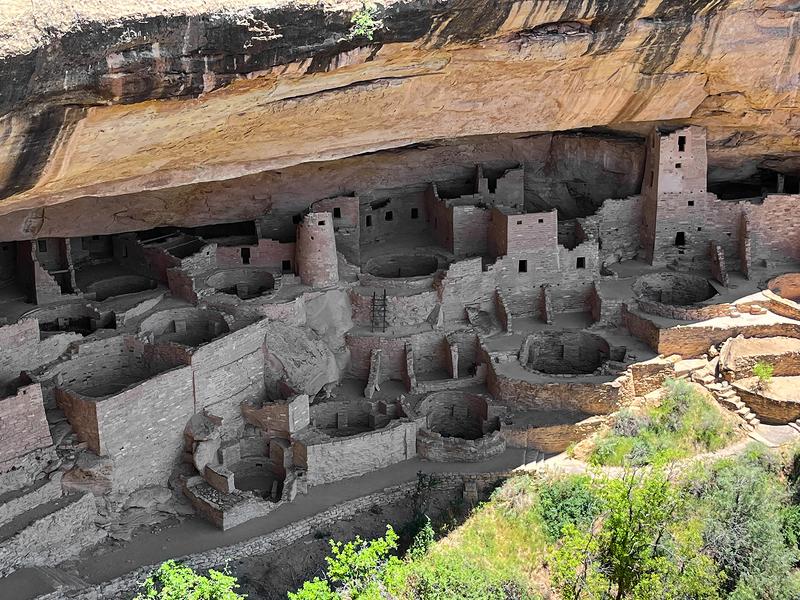Places
__________________________________________
Angel Peak Badlands
About 15 miles southeast of Bloomfield, NM there's a badlands
area around Kutz Canyon and Angel Peak, a sandstone rock
formation sticking up from an eroded mesa in the distance, with
a table top mesa behind it. A half mile gravel road takes you to
an observation point with this view. Kutz Canyon is a larger
canyon to the west that has a road leading into it from the west, according to an excellent guidebook by Mike Hill titled A Guide
to the Hiking Areas of New Mexico. You can walk down a wide
trail more like a road that looks like it probably leads into this
smaller canyon. It's a forbidding place but scenic.
Mesa Verde
A photograph of Cliff Palace, the largest cliff dwelling in
North America, though "great houses" built on canyon
floors such as Pueblo Bonito in Chaco Canyon are much
larger. Mesa Verde has 600 cliff dwellings and 5,000 ruins
over 52,000 acres. It's the largest archaeological preserve
in the US. Cliff Palace was built and occupied between
1190 and 1260 CE, but was abandoned before 1300,
likely due to drought. Mesa Verde is a World Heritage Site.
Most of the mesa lies above 7,000 ft with the highest point
reaching 8427 ft. It's almost entirely covered in forest.
Grand Staircase-Escalante National Monument, UT
Grand Staircase-Escalante NM was established in 1996 in southern Utah by President Bill Clinton with 1.7 million acres, later expanded to almost 1.9
million acres. It's a very remote area of the West, the last territory in the lower
48 states to be mapped. The Grand Staircase is a series of five long cliffs
dropping from 8,000 feet at Bryce Canyon National Park to the Grand Canyon.
East of the Grand Staircase is the Escalante River Canyon and its network of
tributary canyons. It's full of places to explore, bordered by the Paria River
Canyon on the west. I took this photograph with a film camera in the Dry Fork
of the Coyote Gulch tributary of the Escalante River in 2000.
Elephant Canyon, Needles District, Canyonlands NP, UT
This is a photograph from the end of Elephant Canyon looking
back down canyon. This spot has the most stunning view of the
entire Needles District, which is saying a lot. The canyon dead-
ends here, and the shot is taken from the bench above where
Druid Arch, which rivals the best arches in Arches NP, sits. Not
easy to get to here, from Elephant Hill it takes a backpack with
a one or two night stay in one of two reserved campsites in the canyon, plus a 5-7 mile dayhike to the end of the canyon and
the arch, depending on which campsite you get. Or if you can
handle a 10.8 mile dayhike you can forego the overnight stay
in the canyon. Twenty years ago I managed it on a several day
backpack that took me to other places, but that was when I
still thought I was young in my fifties. The Needles District of
Canyonlands National Park is still the favorite place I've been
in all the wild country of the Southwest.
Kasha-Katuwe Tent Rocks National Monument
Generally known as Tent Rocks, it's on Cochiti Pueblo
land and is jointly managed by the BLM and the Cochiti
Tribe. The rocks are formed of pumice and tuff from
pyroclastic flows caused by volcanic eruptions in the
Jemez Mountains 6-7 million years ago, then weathered
into canyons and "tent rocks" with caps made of harder
rock at the top. There are two trails of 1.6 miles and 1.2
miles in the monument. It's a very interesting place that's
anything else I know of in the US.




